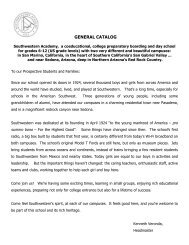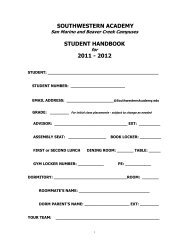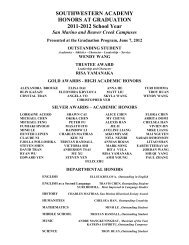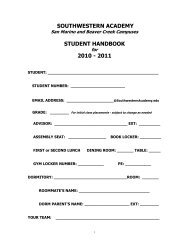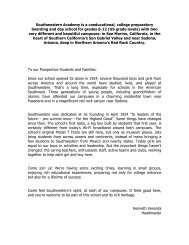Student handbook for 1996-1997 - Southwestern Academy
Student handbook for 1996-1997 - Southwestern Academy
Student handbook for 1996-1997 - Southwestern Academy
Create successful ePaper yourself
Turn your PDF publications into a flip-book with our unique Google optimized e-Paper software.
SOUTHWESTERN’S HERITAGEYou join a rich heritage when you attendthis school and thus become part of<strong>Southwestern</strong>.Over 6,590 other boys and girls have studiedat your school, and many are now involvedin successful careers, family, and service toothers. That has been our school’s purposesince <strong>Southwestern</strong>’s founding in 1924:helping students succeed in reaching theirhighest potentials.Maurice Veronda, the school’s founder,came with his family in 1892 from themountains of northwest Italy to mine coal onthe plains of Illinois. His father learnedEnglish, sent all five children to universities,and became postmaster and countytreasurer.The old wooden clock from “Grampy”Veronda’s post office in Illinois, whichstarted ticking in 1896, still keeps track ofthe time in Pioneer Hall.<strong>Southwestern</strong>’s original seal, designed in1924, is an arrowhead representing theAmerican Southwestand its peoples.Indian villageshad existed nearboth our campuses<strong>for</strong> hundreds ofyears be<strong>for</strong>eEuropeans arrived. The book is <strong>for</strong>knowledge; the swords symbolizepreparedness. This seal is still placed ondiplomas and awards, and is shown in astained glass window in Lincoln Hall.Our western side of San Marino wascovered with orange groves when MauriceVeronda bought the Los Robles Ranch tostart the school in 1924. Pioneer Hall,<strong>for</strong>merly Governor Stoneman’s house, andsome horse barns were the only buildings.A dirt path, later named Monterey Road,wound through the orange trees from SouthPasadena. No other houses were in sight.One of the first jobs was to clear the land <strong>for</strong>Lincoln Hall by cutting down some orangetrees. The hand axe used by our school’spioneers to make the first ceremonial cutswas taken by the first ninth grade class topass along to eighth grade graduates,starting The Tradition of the Axe thatcontinues each June.<strong>Southwestern</strong>’s name was suggested byCharles F. Lummis, a Los Angeles writerand librarian, who saw the <strong>Southwestern</strong>United States - southern Cali<strong>for</strong>nia, Arizona,and New Mexico - as a unique place with aspecial life style and attitude that wouldbring success. Lummis participated in theschool’s dedication ceremony on April 7,1924. Lincoln Hall was built by studentsand teachers in 1925.Cali<strong>for</strong>nia and Illinois dorms with theirdistinctive tower came next, followed by thegym which included UCLA’s old basketballfloor. The Chapel, art building, Founders’Hall dorms, and the Atlantic dorms wereadded more recently.<strong>Southwestern</strong> first enrolled just boys, andstarted graduating students to juniorcolleges at the end of their tenth grade, anexperiment in the Pasadena area that lastedseveral years.From 1934 to 1958, diplomas from<strong>Southwestern</strong> were given to 10 th gradejunior high graduates to enter “juniorcolleges” <strong>for</strong> the next four years in grades11-14, and then receive an Associate degree.San Marino Campus had horses in stablesbetween today’s Chapel and gym. Therewas a little stream with fish at the east endof the campus. Rows of orange trees filledthe areas where fields and dorms are today.Indians had been living along the arroyostream long be<strong>for</strong>e the Spanish came toCali<strong>for</strong>nia. A Gabrieleno (or Tongva) Indianvillage was located about where the artbuilding now stands. This land was part ofRancho San Pasqual, a ranch established bya Spanish soldier who bought everything in29



